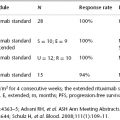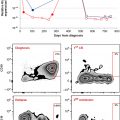Preoperative Systemic Therapy for Breast Cancer
Northwestern University Feinberg School of Medicine, Chicago, IL, USA
1. Is a preoperative endocrine approach reasonable in this patient?
The use of preoperative endocrine therapy has been evaluated in small clinical trials as well as more recent rigorously conducted randomized clinical trials. Because of the favorable toxicity profile of endocrine agents, the first experiences were reported in elderly patients who were considered unfit to receive chemotherapy. Tamoxifen therapy was shown to produce a response rate of >30% in several small studies. One of the key lessons learned from this approach is that a clinical response may require a greater interval of time to achieve compared to chemotherapy. Whereas with chemotherapy some evidence of a response may be evident following 1–2 cycles of therapy, endocrine therapy may require many months of therapy to see clear evidence of tumor shrinkage. A more patient mindset is therefore required for both the patient and clinician. Subsequent studies with preoperative tamoxifen compared to postoperative tamoxifen showed similar overall survival rates. This observation confirmed that even in patients in whom a surgical approach could be considered initially, there was no detriment in patient outcome with preoperative tamoxifen therapy.
More recently, third-generation aromatase inhibitors (AIs) have been evaluated in the preoperative setting for postmenopausal women. This class of endocrine agents is potentially more attractive than tamoxifen because of superior efficacy demonstrated in the metastatic disease setting in postmenopausal women. In a randomized phase II trial (P024), 4 months of preoperative letrozole was compared to tamoxifen in 337 postmenopausal women with clinical stage II or III, ER+ and/or PR+ breast cancer. None of the patients were considered breast conservation candidates at the outset. Patients receiving letrozole were more likely to attain a clinical response (55% vs. 36%; P = 0.001), an ultrasound response (35% vs. 25%; P = 0.042), a mammographic response (34% vs. 16%; P = 0.001) and breast conservation (45% vs. 35%; P = 0.022) compared to those receiving tamoxifen. Letrozole also more clearly reduced the proliferative index of tumor cells (Ki67) compared to tamoxifen. The Pre-Operative Arimidex Compared to Tamoxifen (PROACT) study studied postmenopausal patients with large (T2/T3, N0-2) operable, or potentially operable (T4b, N0-2), breast cancer, who received either tamoxifen or anastrozole. Ultrasound response (39.5% vs. 35.4%), clinical response (50% vs. 46.2%) and operability (43% vs. 30.8%) were all greater in patients receiving anastrozole compared to tamoxifen.
The Immediate Preoperative Anastrozole, Tamoxifen, or Combined with Tamoxifen (IMPACT) trial compared treatment arms of anastrozole, tamoxifen, or the combination of these agents administered preoperatively to patients with locally advanced breast cancer. No difference in clinical response was demonstrated between tamoxifen and anastrozole, and, as predicted by the much larger postoperative Arimidex, Tamoxifen, Alone or in Combination (ATAC) trial, the combination of agents did confer additional clinical benefit or evidence of a greater biologic effect on Ki67. The IMPACT trial evaluated tissue samples at 2 and 12 weeks of therapy, and Ki67 was reduced to a greater degree at both time points in those receiving anastrozole compared to tamoxifen (P = 0.013 and P = 0.0006, respectively). The ACOGSOG Z1031 recruited 374 postmenopausal patients with clinical stage II or III, ER+ breast cancer to be randomly assigned to 16–18 weeks of preoperative anastrozole, letrozole, or exemestane. Clinical response rates or reductions in Ki67 were not statistically different between the three treatment arms.
The P024 and IMPACT studies were also the genesis of the preoperative endocrine prognostic index (PEPI) score, which incorporates tumor size, nodal status, Ki67 level, and ER score. In the P024 study, no patients with T1N0 tumor and a PEPI score of 0 developed disease relapse. In the ACOCOSOG Z1031 study, patients with a Ki67 ≤10% and the Luminal A subtype of breast cancer were both associated with a very high probability of a PEPI score of 0.
The anastrozole-based IMPACT and PROACT trials also showed a trend favoring the AI arm, although the results in comparison with tamoxifen were not statistically significant. A meta-analysis of these trials supported the notion that an AI was more effective than tamoxifen for promoting breast conservation. A promising 76% rate of breast conservation was also observed in a single-arm phase II study of neo-adjuvant exemestane in postmenopausal patients with hormone receptor–positive tumors, 3 cm or greater, after 12 weeks of therapy.
2. How does the pathologic complete response (pCR) rate compare with chemotherapy in ER+ disease?
One of the concerns most often cited by clinicians is the notion that endocrine therapy is less effective than chemotherapy when administered in the preoperative setting. This mindset is difficult to dislodge unless a critical evaluation of available data is undertaken. Although neo-adjuvant chemotherapy with or without trastuzumab is increasingly more effective in producing pCRs, the effect is seen largely in ER− and HER2+ tumors. A report by Guarneri et al. (2006) evaluated the effect of preoperative chemotherapy in 1731 patients, of whom 1163 had ER+ tumors. The pCR rate was 24% for ER− tumors and only 8% for ER+ tumors (P < 0.001). In the GeparTrio study involving 2071 patients receiving different durations of chemotherapy or compositions of chemotherapy depending on the response, a pCR was defined as no invasive cancer in the breast or axilla. There was a striking difference in the rate of pCR favoring the effect of chemotherapy in patients with hormone receptor–negative tumors versus those with hormone receptor–positive tumors, in both patients <40 years (48% vs. 15%) and those ≥40 years (32% vs. 9%). In the recent NeoSphere trial evaluating different anti-HER2 therapy combinations in a preoperative setting, 417 chemo-naïve patients with HER2+ operable or locally advanced breast cancer were randomized to docetaxel–trastuzumab, docetaxel–trastuzumab–pertuzumab, docetaxel–pertuzumab, or pertuzumab–trastuzumab. Interestingly, in the absence of chemotherapy (pertuzumab–trastuzumab), the patients with ER− or PR+ disease had the lowest pCR rate (5.9%) compared to 29.1% in patients with ER− and PR− disease.
Another important observation is that pCR is not as important in predicting outcome in ER+ tumors. Ring et al. (2004) reported on 435 patients who received neo-adjuvant chemotherapy and found that those attaining a pCR had a significant improvement in overall survival compared to those with less than a pCR. However, in those patients with ER+ disease, there was no difference in disease-free survival (DFS) in those with a pCR or not.
Direct comparisons of chemotherapy to endocrine therapy in the preoperative setting are sparse, yet equally revealing. Semiglazov et al. (2007) reported on 121 postmenopausal women with ER+, large operable tumors or locally advanced disease, who received either primary chemotherapy with an anthracycline and paclitaxel or endocrine therapy with anastrozole or exemestane for 3 months. Clinical and mammographic assessment showed equivalent antitumor effects between treatment modalities. The pCR rate was also essentially the same between the groups, but, as might be expected, fewer side effects were seen in patients receiving endocrine therapy. In a similar study by Alba et al. (2012), in 95 premenopausal patients who received either primary chemotherapy or primary endocrine therapy with a combination of exemestane and goserelin, there was no statistical difference between either treatment arm with respect to response rate or mastectomy rate.
3. How long should endocrine therapy be continued in a preoperative setting prior to surgery?
Whereas neo-adjuvant chemotherapy has been administered for durations as short as 3 months prior to surgery, neo-adjuvant endocrine therapy is optimally administered for longer durations. Of 182 consecutive patients treated in Edinburgh with neo-adjuvant letrozole for 3 months or longer, 63 patients have continued on letrozole beyond 3 months. Of the 63 patients who continued on letrozole, 38 patients took letrozole for more than 1 year and 23 took letrozole for more than 24 months. The median reduction in clinical volume in the first 3 months in these 63 patients was 52%. Similar reductions in median clinical volume were seen at 3–6 months, 6–12 months, and 12–24 months (medians 50%, 37%, and 33%, respectively). At 3 months, 69.8% of the 182 patients had a partial or complete response. The response rate increased to 83.5% with prolonged letrozole treatment. Continuing letrozole beyond 3 months increased the number of women who had initially required mastectomy or had locally advanced breast cancer who were subsequently suitable for breast-conserving surgery from 60% (81/134) at 3 months to 72% (96/134).
4. Are there any genomic tests that can predict benefit from preoperative endocrine therapy over chemotherapy?
Several reports have suggested that the 21-gene recurrence score (RS) assay (Oncotype DX™, Genomic Health) may be useful in distinguishing tumors more likely to benefit from endocrine therapy compared with chemotherapy. Gianni et al. (2005) examined the 21-gene Oncotype DX assay in 89 women with locally advanced breast cancer. Reverse transcription polymerase chain reaction (RT-PCR) analysis was performed on core biopsy specimens. Following neo-adjuvant anthracyline–taxane treatment, assessment of the surgical specimens for pCR was performed. The likelihood of pCR increased with higher RS. There were no pCRs in tumors with an RS less than 25, all of which were ER+. Chang et al. (2008) evaluated the utility of RS to predict pCR in 97 patients with locally advanced breast cancer undergoing four preoperative cycles of docetaxel. They found that none of the eight patients with a low RS had a complete response, compared to nine of the 42 patients with a high RS. All 44 patients with an RS <44 were ER+. Akashi-Tanaka et al. (2009) evaluated 87 patients with ER- and PR-positive operable breast cancer who received either tamoxifen or anastrozole for 4 months. A pretreatment core biopsy was performed to assess RS. They found that tumors with low RS tended to have better clinical response compared to those tumors with an intermediate or high RS. Additionally, RS tended to predict clinical response in patients receiving tamoxifen or anastrozole. A low RS tended to have better relapse-free survival (RFS) than intermediate and high RS (5-year RFS: 100% vs. 84% vs. 73%, respectively).
5. What are the advantages of preoperative systemic therapy compared to postoperative adjuvant therapy?







